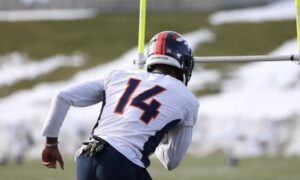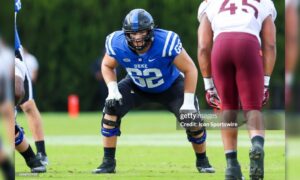Part 1 of this series looked at the core of the offense: the Quarterback and Offensive Line positions. This edition will look at the receiving and running attacks.
WIDE RECEIVERS AND TE’S [outlook as rosy as a maiden’s blush]
Do The Steelers Need A Clear Cut #1 Weapon? A good, modern NFL offense will have:
- one (1) star WR1;
- one (1) solid WR2; and
- one (1) WR3, ideally a youngster with WR1 potential; plus
- three (3) acceptable specialty/depth/teams players; and
- one (1) TE who cannot be ignored as a receiving threat.
Most teams lack one of those first three, and few have depth players they’d be willing to see on the field. The 2020 Steelers are way, way ahead of that standard. This team has:
- three (3!) proven WR2’s, two of whom have good chances at WR1 status (JJSS and Diontae Johnson), while the third (James Washington) has an average chance at that growth; and
- two (2) WR3’s, in Switzer (spare me – he’s fine as a WR3) and the youngster with WR1 potential (Claypool); along with
- several specialty/depth/teams options to choose from (Cain, McCloud, Darboh); plus
- two (2!) TE1’s who’d start on most other teams (McDonald and Ebron).
Good teams have three legitimate receiving weapons plus one solid TE; Pittsburgh has five legitimate receiving weapons plus two solid TE’s. It’s an outrageous surplus of pass catching talent like nothing I can ever remember.
The only weakness is the lack of that all-star, proven WR1 who will tilt the field in predictable ways. Pittsburgh’s array of options all but guarantees that one of them is bound to be open on basically every play. And the sheer number of them allows for so many packages, with such varied skill sets, that no defense could ever prepare for all the variations. But the fact that everything is based on matchups across the field, versus dominating excellence in one location, means the QB has to be good enough to recognize those matchups based on pre-snap formations and adjustments. Those are tough reads; especially if the opponent threatens or brings a lot of pressure. It’s an offense that requires a smart (hopefully veteran) QB and an offensive line that knows how to pass block.
Gee, where can we find a team that sounds like that?
They don’t get a lot more savvy than Big Ben at this point in his career, and the Steelers OL is second to none on the pass blocking front. And please remember that this is the worst case scenario! If Smith-Schuster, Johnson, or Washington matures into a true WR1, the reads will get that much easier and defenses will lose even this limited foothold. Same thing if the defense in question has trouble dealing with the Steelers’ pair of high-powered pass catchers at the TE formation. (We will turn a blind eye to Ebron’s blocking… [Ahem]). Some will even add Chase Claypool into the equation, though this article will refrain based on my longstanding policy against assuming rookie contributions.
With or without the rookie, it’s disgusting. And I’m not the only one who thinks so. “Remember the Young Money crew [Wallace, Sanders, AB]? This group will rival it.” Plus the combination of McDonald and Ebron, instead of just Heath Miller.
Disgusting.
Few if any defenses that can muster a backfield to compete with this depth. And of those that can, how many can stop a running game with so many DB’s on the field? Go back to Part 1 of the series and you’ll see that Pittsburgh’s OL has proven its ability to run against pass-oriented defenses. That is their game. Mobility. The OL only looks weak when there is no QB who can punish opponents for loading the box.
THE RUNNING BACKS [outlook average]
I won’t hide the fact that I spent last Winter hoping for Pittsburgh to draft a running back with true star potential. That wasn’t because I had doubts about Claypool and the draft’s other top WR prospects. I didn’t, and I don’t. It’s just that I would have very few doubts about the WR room even without Chase Claypool, and a durable, multifaceted RB1 would have offered a more obvious benefit to the offense.
That said, it isn’t like the Pittsburgh running backs are downright poor. They suffer more from being unspectacular.
Can James Conner stay healthy, and carry the load if he does? We’ll see about the health, but the rest offers little concern. Conner isn’t the equal of a young Lev Bell, but against a light box and a Nickel defense? The kid should dominate. He’ll look so much like Bettis that we’ll have a hard time keeping casual fans from making those comparisons.
Can Benny Snell step up in Year 2 (and does it matter)? I have expressed a number of questions about Benny Snell, which basically group around his inability to run off-tackle during his rookie season. First and foremost, every report out of training camp says he’s tightened up by a dozen pounds during the offseason, and rebuilt his body to a new NFL standard. We would have a Conner-clone on our hands if that offseason work has gained him an extra step of lateral range. But even if he’s exactly the same player as last year… the 2019 Benny Snell would have chewed the guts out of opponents geared up to defend against the pass. Even this critic believes that Snell should be fine with a healthy Ben (or even a significantly improved Mason) plus that crazy array of passing weapons.
But wait! There’s more. There’s Wendell Smallwood, a proven pro who is better (certainly more rounded) than Snell was in 2019. That removes any real chance of the double whammy, where Conner gets hurt and Snell has a sophomore slump.
And there’s also the new rookie RB, Anthony McFarland JR. Conner and Snell are power backs who (hopefully) have just enough burst to cut toward the sidelines as well. McFarland is the opposite; a flashy speed back with (hopefully) enough power to run inside when that’s called for. If he “arrives”, the team will have a whole new set of big play options that defenses will be forced to address. And if McFarland fails? That leaves Kerrith Whyte, who is to McFarland pretty much what Smallwood is to Snell. Higher floor, lower ceiling. The team can definitely use a player with McFarland’s skill set, but it won’t be lost if this particular prospect fails to make the grade.
All of that adds up to a Running Back room that has no particular weaknesses except the lack of a special talent; and it is a group that should do particularly well as the costar for a dominant passing attack. No, this group won’t carry the team if we end up with another rookie QB4 for a significant part of the season. There is no Franco or Bettis to lean on here, and the offensive line isn’t built to do that either. But so what? The answer is simple: don’t get stuck with your 4th string, rookie Quarterback starting for half your games.
BOTTOM LINE
Pittsburgh’s defense is going to be great, but Pittsburgh’s offense should be awfully darned good as well. This is a “hit ’em where they ain’t” offense, remarkable for it’s diversity rather than it’s proven star power. Good defenses may be able to make the offense one-dimensional by loading up against either the run or the pass, and daring the team to go the other way. The point is that Pittsburgh has all the weapons it needs to take that dare and win. Every. Single. Time. There are just too many weapons, and too many options.
The Achilles Heel of that flexibility is it’s reliance on a veteran QB to take advantage of all the options. The Bradys and Peytons of the world would put up historic numbers in this offense, particularly with this good a defense to back them up. That above-the-shoulders game is where they live(d). How big a step down is Roethlisberger from those competitors for the GOAT throne? We’re about to find out.








